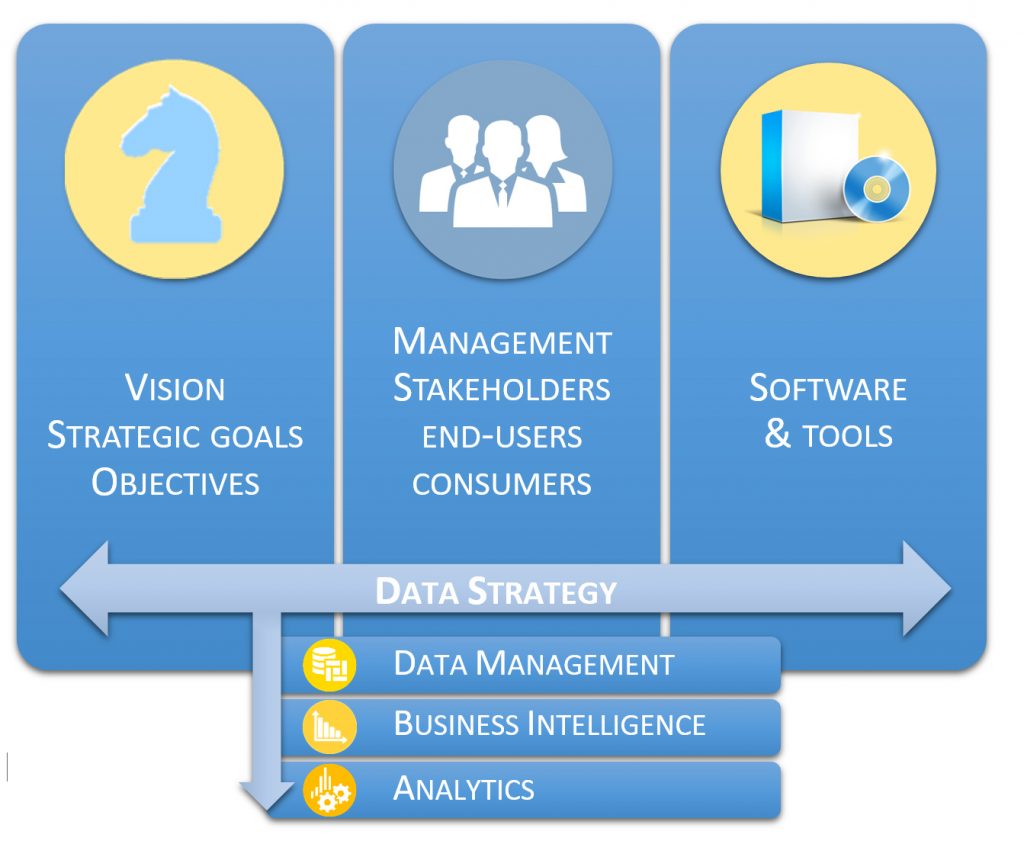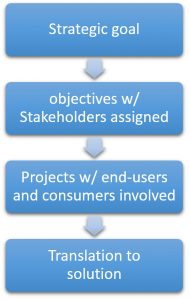In my previous post, I discussed some of the challenges and costs organizations face when they’re stuck in Excel hell with no real data strategy. Now that we’ve discussed the problem, let’s dive into the solution.
Every organization needs a data strategy with these building blocks:
Your top priority is linking your data to company strategy. Here are the steps you need to take:
- Identify strategic goals - i.e. long-term company objectives.
- Break the strategic goal down into objectives. Assign a stakeholder to each objective as the driver/owner of that objective and define initiatives that fall under each objective.
- Create a project work group that includes IT, end-users and information consumers. This small work group will start the project(s) that contribute to the larger initiative. With your first few projects, go for quick wins (projects that show maximum value for a minimum of effort). Early successes will help prove the value of the overall initiative and help get (and keep) the team motivated.
- Translate projects into solutions. The cross-functional project team will work together to address challenges from multiple angles and translate business requirements into actual solutions.
 For example, let’s say that the company’s goal is €25M in new sales through up- and cross-selling.
For example, let’s say that the company’s goal is €25M in new sales through up- and cross-selling.
Our objective is to improve customer experience to help reach that sales goal. First, we need to achieve a single point-of-view on the customer (360° customer view), i.e. know your customer. So, our initiative is: Targeted marketing and marketing automation.
The projects kicked off by the initiative will include: Data integration; data quality; data enrichment; KPI’s; segmentation; and scoring.
The projects translate into the following solutions: Self-service and governed data management; data visualization; self-service and governed reporting; approachable analytics (to build analytical expertise); data mining; advanced and big analytics (later stadium).
This is a comprehensive example that covers a lot of territory, but you can define some quick wins as well. Here are a few examples, by industry:
Logistics
Get a fuel tax refund from the government by creating a report that combines data from the trucks and fuelling stations instead of using data entered manually by the truck drivers. This will avoid human error, save work for the drivers and save you time and money.
Retail
Quickly detect your most (and least) profitable products to help you make pricing updates. Monitor demand and adjust your stock and production in order to guarantee delivery times.
Manufacturing
Negotiate more effectively by creating an overview of key production materials. Or create a network diagram to see the impact of vendor price changes on finished goods.
Finance
Visualize actuals versus budget to quickly see if expenses are in line with expectations. Forecast expenses to see where you’ll finish at the end of the fiscal year, or see how expenses are evolving over time to make a more precise budget for the next year.

Many other quick wins are possible, but these are just a few examples.
One final, important suggestion: Assign ownership of data strategy to someone (Data Strategist, CIO, etc.) who will actively guide it to success. He or she will have to monitor everything closely to detect overlap between initiatives, projects, software and tools when working in parallel. Doing so will save time when projects can be shared or reused for different initiatives, preserving precious IT resources (i.e. no overlap of software solutions in the IT landscape – more on this in my next post).
Conclusion
Ensure that your data is linked to your organization’s strategy and that ownership for that is taken at all levels (goals, objectives, initiatives and projects). Make sure that business and IT are well aligned to come to a solution that works for everyone. Communication between teams is key.
What’s challenging for your business? Have you detected quick wins that you could share? Please reach out if you want to discuss anything related your data strategy or if you want to look for quick wins. Feedback and ideas are welcome as always.
I will go into more detail about the three data domains in my next post, so stay tuned. To see other posts in this series search the tag: data strategy series

1 Comment
Pingback: Cinco beneficios de implementar una estrategia de Data Management que usted debe conocer - SAS Colombia